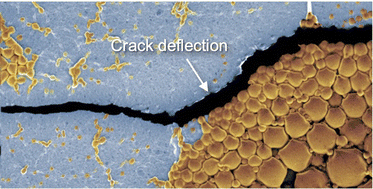The synergistic effect of topography and stiffness as a crack engineering strategy for stretchable electronics†
Abstract
Elastomer-supported metal films are promising candidates for stretchable conductors due to their high conductivity; however, channel cracking of metal films on planar polydimethylsiloxane (PDMS) substrates breaks the conductive pathway at low strains (∼15–30%), limiting their usefulness in wearable devices such as resistive strain sensors. Methods to engineer how cracks form and propagate have mainly relied on adding topographical features to PDMS substrates that act as sites for strain localization and crack initiation, generating a network of micro-cracks with strain that distributes strain relief across the overlying metal film to extend the working range. We previously reported that combining topography and stiffness in a layer of poly(vinyl acetate) PVAc microglobules on the surface of flat PDMS also generates a network of microcracks in an overlying gold film, and that the density of microglobules influences the cracking pattern and accompanying resistance change with stretching. Here, we report a systematic experimental study of four comparison systems that provide insight into how topography and stiffness of PVAc work together synergistically through a mechanism of crack initiation and crack deflection that dramatically changes the cracking pattern and accompanying resistance change.



 Please wait while we load your content...
Please wait while we load your content...